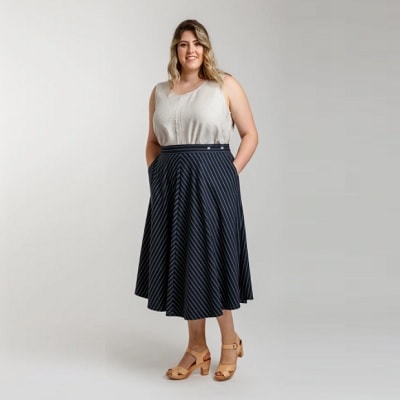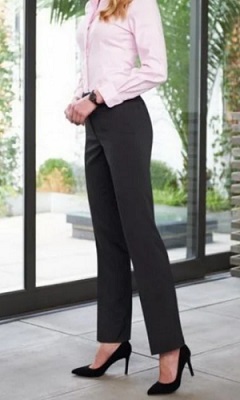This post may contain affiliate links and Corporette® may earn commissions for purchases made through links in this post. As an Amazon Associate, I earn from qualifying purchases.

Whether you've only recently picked up sewing or knitting as a hobby, have been doing it all your life, or are only CONSIDERING it, we thought we'd take a look at some of the best sewing patterns for workwear outfits (with a few knitting patterns as well!).
I can tell you from experience (i.e., the research for this post) that you need to be pretty specific when searching online for sewing patterns for workwear outfits. Otherwise, you'll end up with search results that include dress patterns from the 1940s and patterns for doll clothing… For example, start your hunt with something like “sewing pattern women's skirt -vintage.” (And scroll down to the bottom of this post to find some helpful online resources.) If you DO like vintage-inspired looks, though, Etsy seller The Good Witch Patterns has a ton of promising ones.
If you're a sewist or a knitter, how did you get started with the hobby? Have you tried making your own workwear? What are your favorite sources for knitting or sewing patterns for workwear outfits?
Psst: if you're interested in getting into sewing, readers recommend an entry level Babylock or Janome, warning “do not buy a sewing machine at JoAn or a big-box retailer from a brand like Singer or Brother. Those are garbage and will break right away.” Good to know!
This post contains affiliate links and Corporette® may earn commissions for purchases made through links in this post. For more details see here. Thank you so much for your support!
{related: how to find fulfilling hobbies}
Here are some of the best sewing patterns for workwear outfits and knitting patterns for professional clothes — we'd love for you to share some of your favorites!
Kat recently came across this pattern is from Austrian designer Jutta von Hinterm Stein. It looks so comfortable! The pattern is available on Ravelry for €6.90 (about $8.00 as of Oct. 2021). It's designed for worsted yarn (the site gives some specific suggestions), and the sizes are XS–XXL. Ravelry users can upload their own photos, so you can see the designs on people with different shapes and sizes.
You can buy the pattern for this blazer for a mere $16 — or pay $59 for the pattern plus a course on ClosetCore for “speed tailoring,” which could be really helpful if you want to adapt some older or thrifted clothes either to fit better, be more personal, or be more on trend. (ClosetCore's Pauline dress also looks versatile enough to become a very bust-friendly sheath dress.)
{related: tips on thrifting for workwear — and where to recycle your work clothes}
This pattern for this classic A-line dress comes from The Avid Seamstress, based in London. It's available for £16.50 (about $22 as of Oct. 2021) and is compatible with UK sizes 6–22 (equivalent to U.S. 2–18). The design has optional inner pockets and also includes short/long skirt variations. The site categorizes their patterns by skill level and has tops, pants, dresses, and more.
DG Patterns (aka Daniela Gutierrez-Diaz) is based in Canada and sells her sewing patterns on Etsy (as well as a big selection of fabric, from rayon to French terry to organic cotton). You'll find lots of skirts, dresses, pants, jackets, and more, all downloadable as PDF patterns for $6. This one is the Dajana Dress, which is available sleeveless as pictured or with short sleeves, for sizes 4–22.
It looks like Etsy seller DressyTalk has a lot of great options for workwear, including complicated things (like the 4-in-1 jacket-skirt-coat-bolero pictured above) — as well as simple things, like basic blouses for work. Patterns range from $5–$22.
{related: how to shake things up when you're bored with life}
This pattern ($19) is from Megan Nielsen Patterns in Australia — they offer designs for “contemporary wardrobe essentials” in sizes 0–30. The pictured skirt is for Curve sizes 14–30; there's also a version for sizes 0–20. Not a big fan of midi length? The pattern variations include a skirt pleated above the knee, a skirt gathered below the knee, and a bias-cut skirt above the knee. And … they all have pockets!
Another great option for plus size sewing projects: Muna & Broad.
The pattern for these Slim-Fit Pants from the Russian Etsy shop EK Sewing Patterns (aka Elena Kleber) is currently on sale for only $3! The pants have waist darts and a zipper fly (but no pockets), and EK Sewing recommends that you be at least an intermediate sewist to give these a try. The shop also offers patterns for skirts, dresses, tops, and more.
Resources
- Ravelry
- r/sewing on Reddit
- r/knitting on Reddit
- Sewing articles [The Spruce Crafts]
- Knitting articles [The Spruce Crafts]
- Here’s Where to Find Thousands of Sewing Patterns for Fashion-Forward DIY [My Modern Met]
- Sew a Workwear Capsule: 10 Must-Sew Patterns [Sew Daily]
- Top Tips for Sewing a Blazer [Craftsy]
- Pretty & Professional: Easy Knitting Projects for Office Wear [Stitch & Unwind]
- 9 Sewing Patterns for Wardrobe Classics [Sabrina Lee]
Sewists, and knitters: Do tell! What have been your favorite knitting and sewing patterns for workwear outfits or business casual clothes? Do you use new patterns, vintage, or both?
Pssst: looking for smaller projects?
Here are some easy kits and books to get you started on cross-stitch for stress relief…
Stock photo (woman with sewing supplies and fuchsia tulle) via Stencil.










Anonymous
Me me me, I’m a sewer! I learned as a kid from my mom, she was more into sewing home goods than fashion though. I mostly tailor, upcycle, and alter thrifted clothes vs making my own from scratch. When I do sew from scratch I rarely use a commercial pattern. I either draft a pattern myself, trace an old garment, or use a zero waste ‘pattern’ that relies on an equation. The reason I sew is partly sustainability (it’s really easy to find second hand materials & tools!) and partly quality. I favour natural materials, and high end finishes like French seams so sewing is the best way to achieve my goals.
As for knitting, it’s really hard and so much slower than sewing. I keep trying and I just can’t get into it. I’d love to know of any sewers were able to become knitters.
Anonymous
Note that digital sewing patterns can vary wildly in quality. In this case, quality refers to things like whether the instructions can be followed, take shortcuts that will render the product unwearable, whether the pattern pieces fit together, and how the overall garment fits. Try to seek out reviews before buying (considering the cost of fabric & your frustration too!)
I am a big fan of “Itch to Stitch” patterns. The portfolio is predominantly work-wear oriented, and many of the patterns cover a very inclusive range of sizes (00 to 40). The instructions are super detailed, easy to follow and the fit is amazing. No affiliation other than being a happy & prolific customer.
Agurk
Seconding Itch to Stitch! Also check Michelle Sews, she specializes in work wear. Liesel and Co also has good stuff.
Anon
Love this topic! I make a lot of my own work clothing. That I’m in a creative industry makes it a little easier, but I agree that sometimes sewing pattern samples skew cutsey or vintage and that it can take some work to reimagine them for a more professional context. I have gotten a lot of mileage out of the Closet Core Patterns Cielo dress, lengthened to below the knee and with a back vent added. The Grainline Studio Willow makes a great shell, and their Archer button-up is a good dupe for the Equipment blouse everyone loves. The Gilbert Top from Helen’s Closet makes a good work blouse in a nice fabric. The Merchant and Mills Huron top from their workbook is gorgeous with trousers. I haven’t made anything from them yet, but want to try pieces from The Assembly Line (looks a lot like COS to me) and Just Patterns.
More than the patterns, being able to use really special fabrics is what makes sewing my own clothing worth it to me – that plus a few small fit adjustments is what definitely makes the difference between ready to wear and hand made for me.
Whollyfool
Thanks for these!
Mae
I’ve been sewing for about 3 years and for me sewing is a way to access clothing styles I like that aren’t made in my size. I have to recommend Cashmerette Patterns for the busty sewists, they’ve started to release patterns from size 0-32 (30″ – 62″ bust).
Anonymous
LOVE this post! Will be checking out all the links!
I can knit and sew, and do occasionally wear my own things for work. I’m an excellent knitter, but just okay at sewing.
For sewing I generally adjust and tailor pre-made garments, and can do great invisible hand-stitching to take up wool trousers or change a meh dress into a great skirt. I like to be able to see a top that’s almost perfect and know where to add ten stitches to make it so much more flattering.
For knitting, the trick to making work-appropriate garments is really just accepting that the most successful garment will be dull in terms of texture and construction. I think the most lovely and exclusive hand-knit garments are done in dark colours (ouch for the eyes), on very tiny needles like 2 mmm (ouch for the patience), in very exclusive yarns (ouch for the pocket book) in stockinette (ouch for the creative mind and learning experience). So I mostly knit smaller projects where I can use colour and texture, but still on small needles and with nice yarn. I know people who do more fluffy work pieces, but that ‘s not what I’m comfortable to wear, so I don’t.
Notinlaw
I’m so intrigued to see the responses. I sewed a lot growing up — mostly clothes. Now, my sewing is more limited to mending and home items like duvets, shams, simple curtains and pillow covers.
Anon
I have good luck with Style Arc (https://www.stylearc.com/) but I’m pretty experienced as a sewist. I would not recommend them for beginners, their instructions are at ‘draw an owl’ level of details.
CKB
I almost always check out patternreview.com before sewing a new pattern to see if anyone else has sewn it and what they thought. As for patterns, most of what I sew is from BurdaStyle magazines. I have a small-medium sized collection that I go back to over & over. They do require tracing and adding seam allowances, but I’ve got used to adding those steps to my project timeline.
Claudia
It’s like this post was tailormade for my interests! I’m forever sad that there isn’t a Ravelry for sewing patterns, as I find the comments and project notes knitters leave on patterns invaluable. I would highly recommend the closest equivalent I’ve found though, which is The Fold Line – it’s a fantastic way to browse patterns by type, and to find notes from fellow sewists. (Their YouTube episodes are also a great way to find new patterns & designers!)
For the knitters out there – I’ve found that Knitspot patterns (from designer Anne Hanson) are some of the best out there. Well-written, beautifully designed, and a magnet for compliments. 10/10 all around!
Whollyfool
Definitely check out patternreview.com! Great pattern reviews and the forums are full of friendly knowledgeable people willing to help if you get stuck.
noname
Second the cashmerette rec, although many of them do not come in my size yet.